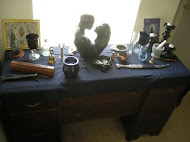GOD & GODDESSES ASSOCIATED WITH CAULDRONS
Most info from Encyclopedia Mythica
Arthur - The Spoils of Annfwn (Preideu Annwfn) is a short Welsh poem,
dating from ca. 900, found in the Book of Talisien. It describes an expedition by Arthur and his followers to a city (possibly an euphemism for the Otherworld) where he obtains a magic cauldron. The text itself is rather enigmatic.
Bran - Bran's Cauldron of Renovation (Celtic) - It brought the dead back to life. The son of Haon, Bran was the giant king of distant haunted lands and could sail to the lands of the dead. He guarded the Cauldron of Life. He battled the children of Tir. He was finally beheaded, but his head remained alive for many years, able to prophesy.
Brigyth - This goddess guards the Cauldron of Inspiration. She has given much lore to mortals, including most crafts and the art of poetry. In some ancient tales, she is the only goddess with the skill to purify other gods who have become tainted or grievously dishonored in some way. Some modern scholars have sought to identify her with Save-K'nor.
Ceridwen - Cerridwen is the Welsh goddess of dark prophetic powers. She is the keeper of the cauldron of the underworld, in which inspiration and divine knowledge are brewed.
Dagda - Dagda's Cauldron (Celtic) - The Cauldron, Undry, had the ability to feed all who came to it and from which none left unsatisfied. Dagda is the father god of Irish mythology, his name means 'The Good' he is master of all arts and knowledge, and can be seen as one of the most powerful gods in the Irish Celtic pantheon. His symbols seem to have been the cauldron (inspiration and wisdom), and the club (probably primal power). His cauldron also has the power to restore life, and was always full, providing endless nourishment for his peoples. The cauldron appears much in Celtic mythology and becomes amalgamated into traditions of the grail in the later Arthurian Romances.
Dagyd - He is the god of fate and a master of all skills. He guards the Cauldron of Plenty. The changing of the seasons is caused by the songs of his magical harp.
Emma-o - The Japanese Buddhist god of the underworld (from the Sanskrit Yama). He lives in the Yellow Springs under the earth in a huge castle all covered in silver and gold, rosy pearls and other jewels. He is the judge of the dead and notes the sins of those who are sentenced to purgatory, and decides the degree of their punishments according to Buddha's Law. Anyone who has killed an innocent will be thrown into a boiling cauldron full of molten metal. However, if they have made a pilgrimage to each of the 33 shrines of the goddess of mercy Kannon, then all the evil they have done will disappear. Sometimes he is portrayed less pitiless and returns life to those who appear before him. On the last day of the Festival of the Dead, the sea is full of shoryobuni ('soul ships'), for on that day the high tide brings a flood of returning ghost who go back to their spirit world. The sea is luminescent with the light these souls emit, and their whispering can be heard. While the ghosts are embarking, no human ship should come near. Should one stray into the soul-covered sea, the ghosts will ask for pails. The sailors should only offer them pails without bottoms, for if they do not, the ghosts will sink their ship. Currently, Emma-o is used as a bogeyman to scare little children.
Hymir - (Norse) Hymir is a sea giant, the husband of Hrod, who lives at edge of the heaven. He possessed an enormous cauldron which the Aesir coveted because they could brew enough beer in it for all the gods, and Thor was sent to obtain it. In the final battle against the gods, Hymir will sail the terrible ship Naglfar, which is made entirely from the nails of the dead. The flood that precedes Ragnarok will free the ship after which the giants will board it and, with Hymir as commander, sail towards the battlefield of Vigrond.
Medea - In Greek mythology the Witch goddess Medea restored people to youth
in a magic cauldron.
Mider - Mider's Cauldron (Gaelic) was stolen by Cuchulainn in his foray into the Underworld, it is said that in it "was always found an inexhaustible supply of meat, with treasure of silver and gold to boot".
Pryderi/Manawyddan - (Celtic) Pryderi and Manawyddan as co-rulers of the Underworld shared ownership of a magic cauldron of inspiration. Supposedly it was the artifact that later became known as the Holy Grail.
Taliesin - The great Welsh bard Taliesin received his wisdom and skill from the goddess Cerridwen's cauldron.
From: "L CARTER"
To Gain Prophecies fill a cauldron half-full of water and place it on a table where you can see comfortably into it while seated. Light two purple candles and a good divinatory incense; a combination of mugwort and wormwood works well for divination. Arrange the candles so their light does not shine into the water or your eyes. Focus your attention on the bottom of the cauldron, your hands placed lightly on either side. Breathe gentle onto the water. Say:
Great Mother, open my inner eye that I may truly see."
Empty your mind as much as possible; remain relaxed while looking deep into the cauldron waters. The answers may come in images in the water, pictures in your mind, and/or strong bursts of "knowing."
Interested in building an indoor cauldron fire, but not interested in dying or setting off the smoke alarms? Here's a suggestion: Mix equal parts Isopropyl Alcohol and Epsom Salts by weight. The by-products are mostly harmless, and it doesn't burn as hot as straight alcohol. Be sure to practice good fire safety, placing the cauldron well away from flammable materials, and on a fire-proof surface, and making sure to have fire dousing materials (such as a lid for smothering the cauldron, and a large box of baking soda for dousing anything unexpected) handy.
Materials Needed:
Cast-iron pot or cauldron of any size
Lid that fits snugly, for putting out the fire
Hot plate or other heat-resistant material to set the cauldron on
Epsom salts
rubbing alcohol
Any cast iron pot can be made into a cauldron with a fire of Epsom salts and rubbing alcohol. This is a very safe blaze (still be careful!). Once the cauldron is secured on a heat-proof surface, pour the Epsom salts in until the bottom is covered, approximately 1 inch deep. Pour rubbing alcohol over the salts until the alcohol is about an inch higher than the salts. Hold a lighted match just above the alcohol. The liquid will light and produce a strong orange flame. The flame burns cool, unlike a wood fire, and is difficult to burn things in. When the flame gets low, cover to snuff out completely. Add more rubbing alcohol to the cauldron and relight carefully. The warmer the rubbing alcohol, the quicker it ignites. This fire
recipe leaves a significant amount of sediment in the cauldron.
by Ammond ShadowCraft
We form the Circle, the Circle most round.
We form the Chalice, the Chalice now found.
We call the Goddess, to meet the great need.
We call the God, to plant His fertile seed.
We call the quarters, which we call four.
We summon the powers, that contain the force.
We stir the Cauldron, from which we were born.
We call the Gods, from whom we were torn.
We say the words, which lead us round.
We pass the kiss, with our lovers found.
We face our dreams, in nights psychic flight.
We face our hopes, in bright moon of the night.
We face our fears, on the Dark Lords Horn.
We face our failure, in the Mother's new planted corn.
We live our lives, drumming and dancing on the meadow.
We confront our Death, in the dancing moon light shadow.
Our paths run quickly, on fleet foot and wing.
Our Circle is joyous, with our Queens and our Kings.
Let our little Circle be happy, with Bell, Bowl or Bow.
And form now this Circle, with gracious Love, Joy and Hope.
The cauldron or pot symbolizes cyclical time and the lunar calendar. This is because the cauldron represents the womb of rebirth, the bowl of blood held by the Hindu Kali and other goddesses. This blood is the Wise Blood from the Cosmic Womb. It has been called soma by the Hindus, red claret by the Celts, and greal by the Welsh Bards. In Vedic myth, Indra stole the soma so that he could rule over all the gods, a reference to the stealing of importance and power from the Goddess for a patriarchal god.
The Goddess and Her cauldron is the center of all feminine power and every female group. Spiritual transformation can only come through Her cauldron,or belly-womb. Ancient tradition says that only women can tap into the great power of the cauldron, for only women are made in the image of the Goddess with Her all-renewing womb of rebirth and transformation. This tradition remains in the figure of the witch and her cauldron.
The cauldron is also the repository of inspiration and magick, as seen in Cerridwen's cauldron which was sought by the Bards. The Goddess has long been considered to be the source of inspiration and the Mistress of Magick. When a true initiation takes place, the initiate willingly descends into the cauldron, she is often filled with ecstatic emotions when she returns to her present state. She may sing, play music, dance, prophesy, see visions, or become creative in poetry and prose. In short, she is filled with Goddess spirit and inspiration, the type of power that only comes from the sacred cauldron. Such Bards as Taliesin stated that they regularly "drank" from the cauldron to promote their creativity and divine inspiration.
Magickal Meaning: development of psychic gifts; creative talents being used. Coming to terms with physical death, either through the death of someone close to you, or a very personal experience in dreams and/or meditation."
-author unknown
Another popular association with Samhain is the magic cauldron. In addition to symbolizing the womb of the Goddess, the cauldron is the Celtic symbol for rebirth. As the season of Samhain concerns the transition from life into death (and from there, into life again), the cauldron and Samhain just seem to go together. If you don't work with the Faerie, a huge black cast iron cauldron is wonderful to have for your rituals and spellwork. If, like me, you work with the Faerie on a regular basis, you'll want your cauldron to be of brass, silver, or copper. You can fill the cauldron with salt or sand and create a gigantic incense burner or fill it with New Moon Water to use it for scrying. You can pile it full of apples for a holiday
If a Witch's brew continues to boil after it has been removed from the fire, it is said to be a sign that the Witch will live to be a ripe old age! This omen originated in Europe in the Middle Ages.
A quarrel with a friend or family member is portended if a Witch's brew should accidentally be spilled on the carpet. However, it is said to be a sign of good luck to accidentally spill some upon yourself.
It is bad luck to brew philtres (love potions) wen the moon is in a waning phase or during the time know as the dark of the moon. The ideal time is during a waxing moon, especially on Valentine's day.
If two Witches stir the same brew, they will be stirring up strife, according to an old superstitious belief from England. If they both drink it from the same cup, it will bring them bad luck unless they are married or handfasted to each other.
It is said to be extremely unlucky for any Witch to heat his or her own brews and potions in a tea kettle or cauldron belonging to another. (To avoid this, a good rule of thumb is to always use your own magical tools.)
If a lady and a gentleman pour out a cup of brew from the same pot, this is an omen that a child will be born to them. If two women pour, one of them will give birth to a red-haired set of twins within the year.
It is an invitation to poverty and misfortune should you throw away herbs that are leftover from potions and brews. For good fortune to smile upon you, always dispose of used herbs by casting them into a fire.
A stranger will soon be arriving on your doorstep if you accidentally leave the lid of the tea kettle or cauldron off while preparing a magical brew. This superstitious belief hails from Victorian-era England.
It is said to be unlucky to stir a Witch's brew in a counter-clockwise direction. To do so creates bad vibrations and attracts negative influences. Always stir in a clockwise direction.
If your left eye itches while you are brewing a potion, this is an omen that sorrow shall soon find its way into your life. An itching of your right eye indicates precisely the opposite. How and where these originated is a mystery.
unknown author
Using a cauldron, symbol of inspiration and rebirth, has brought new dimensions to both group and solitary work. A cauldron decorates the center of the Circle during Lesser Sabbats. An air cauldron at a spring rite creates a misty, magical quality for the ceremony. In summer, the cauldron will flash and spark. A blue flame burns mysteriously within the Water cauldron during the autumn festival. Throughout Yule, the Earth cauldron burns steadfast and constant. During moon rites, when magic is done, we write the purpose of our working on flash papers and toss them into the burning cauldron while chanting. A working cauldron should be of cast iron, with a tight-fitting lid, three sturdy legs, and a strong handle. Season your cauldron before using it for the first time. Pour in a generous helping of salt and lighter fluid, slosh it up to the rim and wipe dry. For indoor use it MUST have a fireproof base or your workings will summon up yellow-coated salamander spirits from the fire department.
Layer salt, wax shavings, three powered or ground herbs, fighter fluid and ivy leaves in the cauldron while focusing and chanting. Use a candle to light it. When the smoke starts to roll, extinguish the cauldron by putting the lid on.
Using tongs, put a chunk of dry ice in a small glass or ceramic bowl and place the bowl on a cloth in the bottom of the cauldron. Allow the cauldron to smoke as long as the ice lasts. The mists create excellent images for scrying.
Cover the inside bottom with dirt or sand to dissipate. Light incense charcoal and add either saltpeter for flame and spark or flash powder for a different but spectacular effect. To assist in releasing or firing off peak energy, try using flash "bombs". Make a small pocket in a piece of flash paper, fill with flash powder and tie with thread. The "bomb" should be about the size of your smallest fingernail. The results are spectacularly bright, so use the powder sparingly. Don't look directly at the flash as you drop the "bomb" in the cauldron.
At least seven days before the ritual, place equal quantities of three appropriate herbs in a pint glass jar. Fill the rest of the jar with Everclear (200 proof alcohol), cap tightly, and shake gently while concentrating on the purpose of the ritual. Add a chant if its feels right. Let the jar rest in a dark, warm spot and shake twice daily, charging with purpose. Before the ritual, place a fireproof ceramic or glass bowl in the cauldron. Pour in the herb mixture, being careful none spills into the cauldron. Light with a candle to produce a beautiful blue flame.
The cauldron, as the fifth elemental spirit, symbolizes inspiration, rebirth, illumination and rejuvenation. Use a Fire cauldron with saltpeter to cast a Circle. Use the mists of an Air cauldron for an initiation. Burn away hate, prejudice and negative self-images, with a Water cauldron. The Earth cauldron is ideal for indoor Beltane rites. Remember to place a burning cauldron on a fireproof surface. Practice safety when using any volatile materials and you will enjoy your cauldron for many rites.
Disclaimer: No one involved in this blog or its contents may be held responsible for any adverse reactions arising from following any of the instructions/recipes on this list. It is the reader's personal responsibility to exercise all precautions and use his or her own discretion if following any instructions or advice from this blog.
















1 comment:
Book of Talisien. I have read some of this - 'The spoils of Hell'. Isn't this meant to be a depiction of one of the nine 'Arthurs' - the rescuer from hell? Just like the myths of Theseus, Herakles, Orpheus, Cuchulainn, Amatheon, Gwydion and even Jesus... But then, it's been a while since I read into that stuff... I've got vampires to pretend to be these days...
Post a Comment